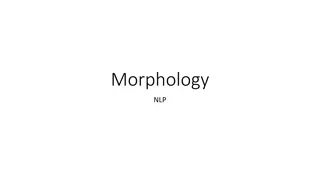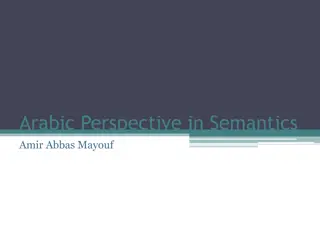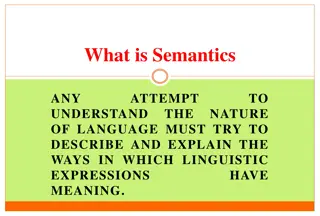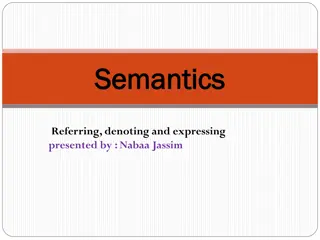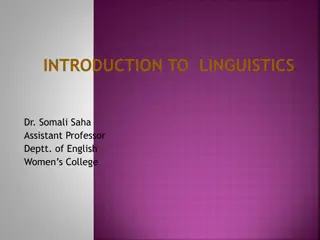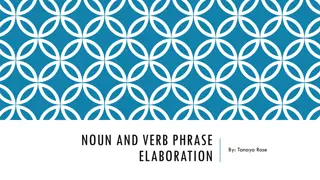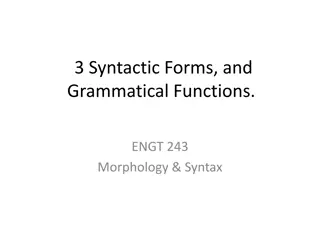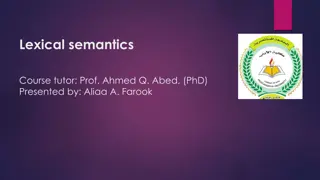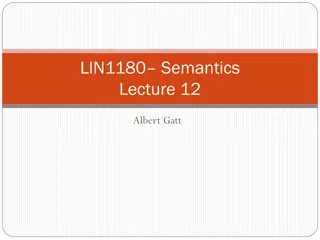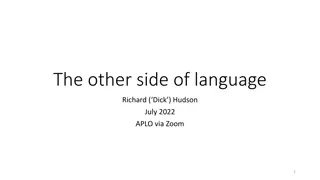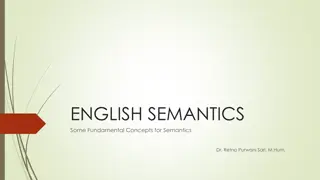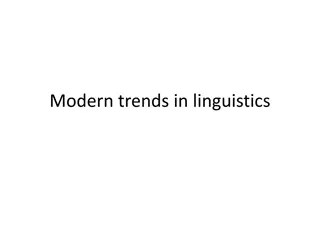Understanding Grammatical Semantics in Linguistics
Grammatical semantics is the study of meaning conveyed by grammatical devices, exploring the semantics of syntax and morphology. By analyzing sentences about a mouse in the countryside, propositions are identified through a four-step analysis, revealing how meaning is constructed through linguistic structures.
- Grammatical Semantics
- Linguistics Analysis
- Proposition Identification
- Grammar Study
- Language Meaning
Download Presentation

Please find below an Image/Link to download the presentation.
The content on the website is provided AS IS for your information and personal use only. It may not be sold, licensed, or shared on other websites without obtaining consent from the author. Download presentation by click this link. If you encounter any issues during the download, it is possible that the publisher has removed the file from their server.
E N D
Presentation Transcript
Grammatical Semantics The study of meaning conveyed by grammatical devices By Dr. Retno Purwani Sari, S.S., M.Hum.
A sentence may represent one or more propositions. A sentence, as a grammatical construction, captures grammatical semantics: semantics of syntax and semantics of morphology. (Wierzbicka, 1988:3).
Identify Propositions using four steps of the analysis There was once a small brown mouse who lived in a little nest at the edge of a field, deep in the countryside. Life in the countryside was not easy and he had to work hard to find food, but he was perfectly content. He had many good friends, his nest was cozy and comfortable and after a hard day s work, he always slept well and woke refreshed, to the sounds of nature.
(1) There was once a small brown mouse who lived in a little nest at the edge of a field, deep in the countryside. [which was] [which was]
(1) There was once a small brown mouse (2) (who) lived in a little nest at the edge of a field (3) [which was] deep in the countryside (4) [which was] at the edge of a field
a small brown mouse (1) A mouse was small (2) A mouse was brown a little nest (3) A nest was little the edge of a field (4) The edge is part of a field
There was once a small brown mouse who lived in a little nest at the edge of a field, deep in the countryside. (1) There was once a small brown mouse (2) A mouse was small (3) A mouse was brown (4) [the mouse] lived in (a specific place) (5) A nest was little (6) [the nest was] at the edge of a field (7) The edge was a part of a field (8) [the field was] deep in the countryside
(2) Life in the countryside was not easy and he had to work hard to find food, but he was perfectly content. [which was] (1) life in the countryside was not easy (2) life was in the countryside (3) (and) he had to work hard (on something) (4) he found food (5) (but) he was perfectly content Back
(3) He had many good friends, his nest was cozy and comfortable and after a hard day s work, he always slept well and woke refreshed, to the sounds of nature. [and] (1) He [the mouse] had friends (2) His nest was cozy (3) [his nest] was comfortable (4) (and after) a hard day s work, he always slept well (5) [he always] woke refreshed (6) [he always] woke to the sound of nature (7) The friends are many (in numbers) (8) The friends are good (9) Nest belongs to [the mouse] (10) work represented for a the whole day Back
Abstract Noun Semantics of Morphology The abstract nouns, life and work represent what is semantically an EVENT. (1) Life in the country side [the mouse] lived (in the countryside) (2) a hard day s work [the mouse] worked hard for a day
More Cases (4) John rejected Peter s offer. John rejected Peter offered (5) Disobedience brings much suffering. [someone] disobeys [someone] suffers (6) The destruction of the city was planned well [someone] destroyed the city [someone] planned well
1. These propositions create a semantic relation, introducing logic in semantic analysis (Rambaud, 2012:65). 2. A proposition can be encoded in a wide variety of grammatical structures (Larson, 1984:190). Back
Three Semantic Categories Participants Three Semantic Categories Process Circumstances
Time (temporal) Place Means Manners Quality Circumstances Comparison Reason Cause Purpose Accompaniment Behalf Matter Role
Extended Analysis: 1. Type of propositions 2. Semantic category: thematic roles, types of process, and type of circumstances There was once a small brown mouse who lived in a little nest at the edge of a field, deep in the countryside. Life in the countryside was not easy and he had to work hard to find food, but he was perfectly content. He had many good friends, his nest was cozy and comfortable and after a hard day s work, he always slept well and woke refreshed, to the sounds of nature.




